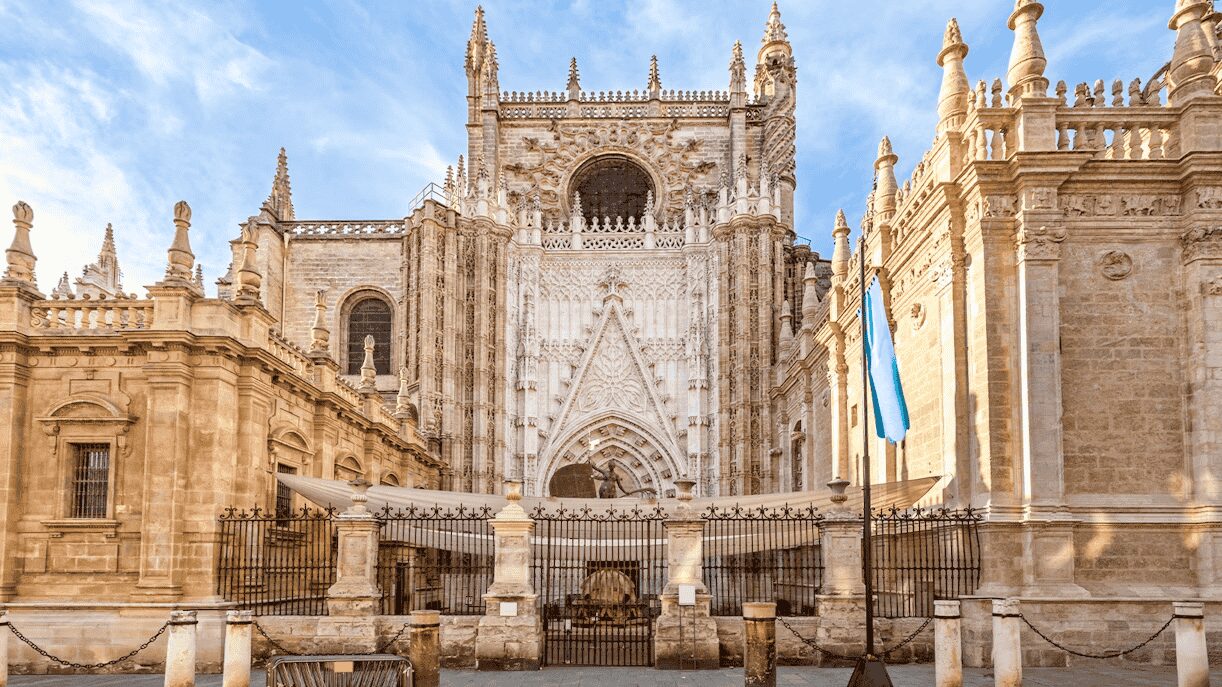Seville Cathedral, officially known as the Cathedral of Saint Mary of the See, is a grand architectural masterpiece located in the heart of Seville, Spain. As the largest Gothic cathedral in the world and a UNESCO World Heritage site, it attracts millions of visitors every year. A visit to this majestic structure offers a chance to experience centuries of history, stunning art, and cultural significance. Here’s a closer look at Seville Cathedral’s rich past, cultural highlights, and practical tips for a memorable visit.
A Glimpse into the History of Seville Cathedral
Seville Cathedral was built between 1401 and 1528 on the site of a former mosque, following the Christian Reconquista of the city. The goal was to create a cathedral so impressive that future generations would marvel at its scale and beauty. Today, it stands as a symbol of Seville’s religious and architectural heritage.
The mosque’s influence is still evident in parts of the cathedral, such as the Patio de los Naranjos (Courtyard of the Orange Trees) and the iconic Giralda Tower, which was originally a minaret. The cathedral was designed in the Gothic style, with later additions in Renaissance and Baroque styles. Its immense size and intricate details reflect the ambitions of its creators, making it a landmark of historical and cultural significance.
The Cultural Significance of Seville Cathedral
Beyond its architectural grandeur, Seville Cathedral holds deep cultural and religious importance. It has served as a central place of worship for centuries and continues to be an active religious site. The cathedral is also a key location for several of Seville’s most important cultural events, particularly during Holy Week.
Seville’s Semana Santa (Holy Week) is a grand celebration filled with processions, music, and centuries-old traditions. The cathedral plays a pivotal role in these events, with thousands of locals and tourists gathering to witness the processions of religious statues through the city streets. This deep connection between the cathedral and the city’s cultural identity makes it a must-visit for those seeking to understand Seville’s traditions.
Architectural Marvels and Must-See Features
The architecture of Seville Cathedral Tour is a breathtaking blend of Gothic, Renaissance, and Baroque styles. Visitors are often struck by the sheer scale of the building, with its massive stone walls, soaring arches, and stunning stained-glass windows. Inside, the cathedral houses numerous artistic and historical treasures.
The High Altar is one of the most impressive features, standing as the largest altarpiece in the world. Covered in gold leaf, it depicts scenes from the life of Christ and the Virgin Mary with extraordinary detail. Another must-see is the tomb of Christopher Columbus, supported by four statues representing the kingdoms of Castile, León, Aragon, and Navarre—a unique and symbolic tribute to the legendary explorer.
Climbing La Giralda Tower
La Giralda, the cathedral’s bell tower, is an iconic symbol of Seville. Originally built as a minaret for the mosque, it was later converted into a bell tower. Its unique design features 35 ramps instead of stairs, allowing riders on horseback to ascend to the top.
The climb up La Giralda is a highlight for many visitors. Once at the top, you’ll be rewarded with spectacular panoramic views of Seville, including landmarks like the Alcázar and the Guadalquivir River. It’s an unforgettable experience that offers a new perspective on the city’s beauty.
The Peaceful Patio de los Naranjos
Adjacent to the cathedral is the Patio de los Naranjos, a serene courtyard filled with orange trees and a central fountain. This courtyard is a remnant of the mosque that once stood on the site and offers a quiet retreat from the hustle and bustle of the city.
The tranquil atmosphere of the Patio de los Naranjos makes it a perfect spot for reflection and photography. It’s also an ideal place to admire the blend of Moorish and Gothic architecture that defines the cathedral complex.
Practical Tips for Visiting Seville Cathedral
To make the most of your visit, it’s best to plan ahead. The cathedral can get crowded, especially during peak tourist seasons and religious festivals. Arriving early in the morning or late in the afternoon will help you avoid the busiest times.
Guided tours are highly recommended, as they offer valuable insights into the history and architecture of the cathedral. Comfortable shoes are essential, particularly if you plan to climb La Giralda Tower. Photography is allowed in most areas, so be sure to bring a camera to capture the stunning details and views.
Inside Seville Cathedral: A Journey Through Time
Seville Cathedral, officially known as the Cathedral of Saint Mary of the See, stands as a monumental testament to Spain’s rich history and architectural brilliance. Recognized as the largest Gothic cathedral in the world and a UNESCO World Heritage site, it has been a cornerstone of Seville’s culture and religion for centuries. Entering the cathedral is like stepping back in time, offering visitors an immersive experience filled with history, art, and architectural marvels.
A Historical Overview
Seville Cathedral’s history is closely tied to the evolution of Seville itself. Built between 1401 and 1528, the cathedral replaced the city’s former mosque after the Christian Reconquista. The goal of its construction was ambitious: to build a structure so grand that, in the words of its creators, “those who see it will think we were mad.” The result is a vast and awe-inspiring building that reflects the city’s religious fervor and wealth during the late Middle Ages.
The mosque’s legacy remains evident in certain parts of the cathedral, particularly in the Patio de los Naranjos (Courtyard of the Orange Trees) and La Giralda, the former minaret turned bell tower. Over time, Renaissance and Baroque elements were added, giving the cathedral a multi-faceted architectural identity.
The Immense Interior and Central Nave
Upon stepping inside Seville Cathedral, visitors are immediately struck by its sheer size and grandeur. The central nave, with its soaring 42-meter-high ceiling, creates a breathtaking sense of space. Light filters through magnificent stained-glass windows, casting colorful patterns on the stone walls and floors.
The interior is divided into multiple naves and chapels, each adorned with intricate carvings, sculptures, and paintings. The vastness of the space encourages quiet reflection, while the ornate details keep visitors constantly engaged. The cathedral’s design successfully blends Gothic elegance with religious solemnity, making it one of the most awe-inspiring interiors in Europe.
The High Altar: A Golden Masterpiece
At the heart of the cathedral lies the High Altar, an extraordinary work of art and devotion. Standing more than 20 meters tall, it is the largest Gothic altarpiece in the world and is covered entirely in gold leaf. This stunning structure took nearly a century to complete and features intricate carvings that depict scenes from the life of Christ and the Virgin Mary.
The High Altar is a focal point for visitors and worshippers alike, symbolizing the spiritual importance of the cathedral. Its golden glow fills the interior with a warm light, making it one of the most memorable aspects of the visit.
Christopher Columbus’s Tomb
One of the most significant historical treasures within Seville Cathedral is the tomb of Christopher Columbus. The tomb is an impressive monument held aloft by four statues representing the kingdoms of Castile, León, Aragon, and Navarre. It serves as a tribute to the famous explorer and his contributions to the Age of Discovery.
Columbus’s remains have been the subject of much debate over the years, with several countries claiming to house them. However, DNA tests have confirmed that part of his remains rest in Seville Cathedral, making this tomb an essential stop for history enthusiasts.
La Giralda: The Tower with a View
La Giralda, the cathedral’s bell tower, is one of Seville’s most iconic landmarks. Originally built as a minaret in the 12th century, it was later converted into a bell tower after the Christian conquest. Its unique blend of Islamic and Renaissance styles makes it a fascinating architectural feature.
Climbing La Giralda is a must for visitors seeking the best views of Seville. Instead of stairs, the tower features a series of 35 ramps that were designed to allow riders on horseback to ascend. The panoramic views from the top are breathtaking, offering a full sweep of Seville’s historic center and beyond.
Art and Treasures in the Side Chapels
Seville Cathedral is home to numerous chapels, each filled with religious art and historical artifacts. These chapels house works by renowned artists such as Murillo and Zurbarán, as well as elaborate altarpieces and sculptures. The Sacristy, in particular, contains a collection of gold and silver religious objects that showcase the cathedral’s wealth and artistic heritage.
Each chapel has its own story and significance, offering visitors an opportunity to explore the cathedral’s history from different perspectives. These hidden corners are often quieter and more reflective, providing a peaceful escape from the busier areas.
Patio de los Naranjos: A Peaceful Retreat
The Patio de los Naranjos, or Courtyard of the Orange Trees, is a tranquil space that connects the cathedral to its Islamic past. Originally part of the mosque, this courtyard is filled with rows of orange trees and features a central fountain.
Many visitors take a moment to rest here and enjoy the serene atmosphere. It’s also an ideal spot for photography, with its combination of Moorish and Gothic elements offering a unique visual contrast.
Visitor Tips for an Unforgettable Experience
To make the most of your visit to Seville Cathedral, plan ahead and arrive early to avoid large crowds. Guided tours are highly recommended, as they provide valuable insights into the cathedral’s history and art. Be sure to wear comfortable shoes, especially if you plan to climb La Giralda. Photography is allowed in most areas, so don’t forget your camera to capture the stunning details and panoramic views.




































